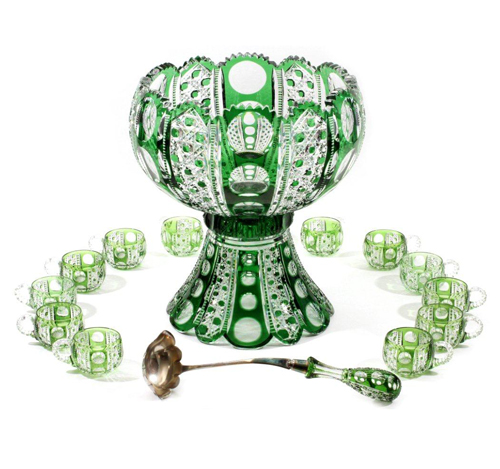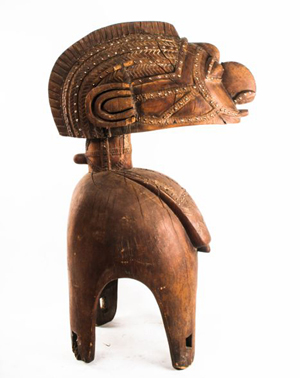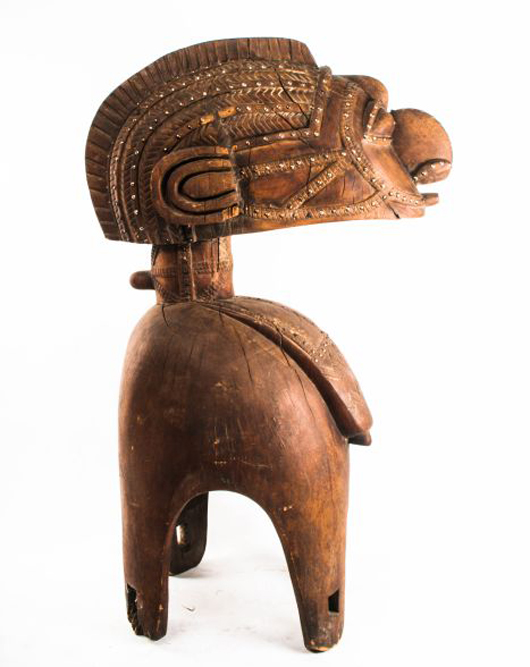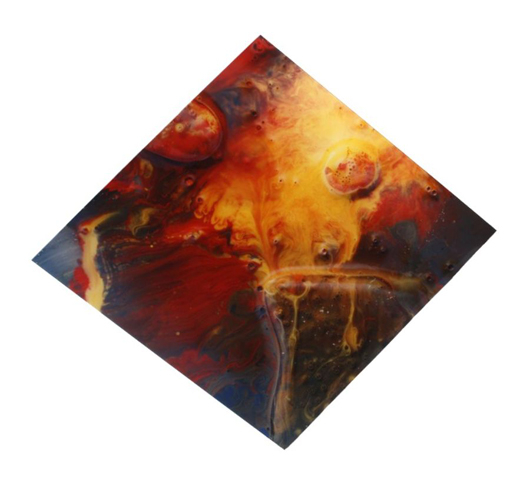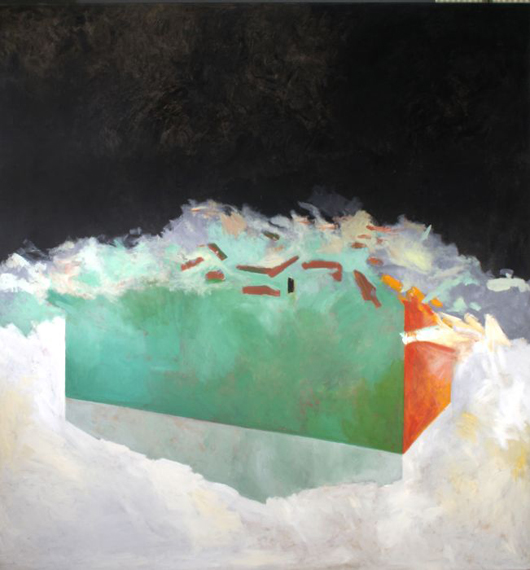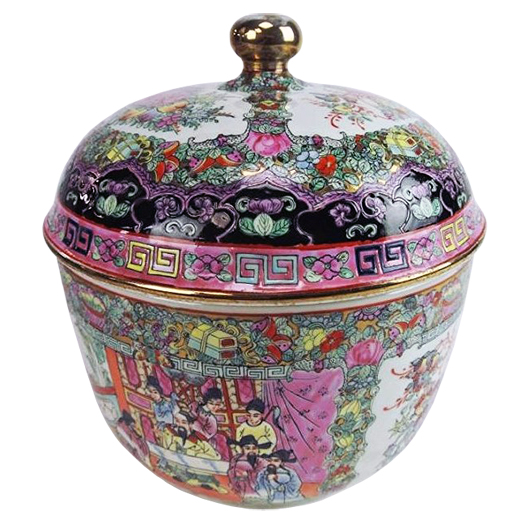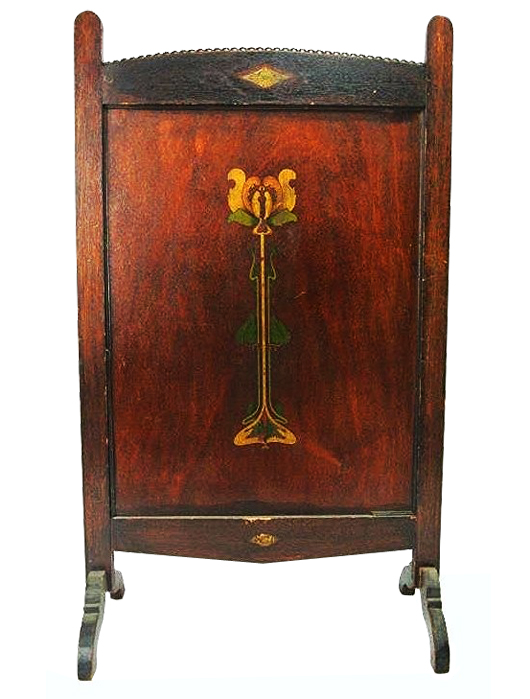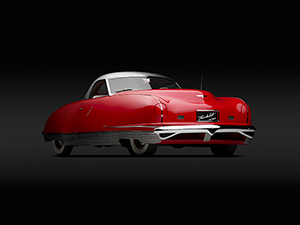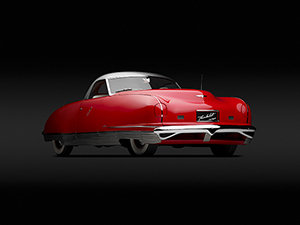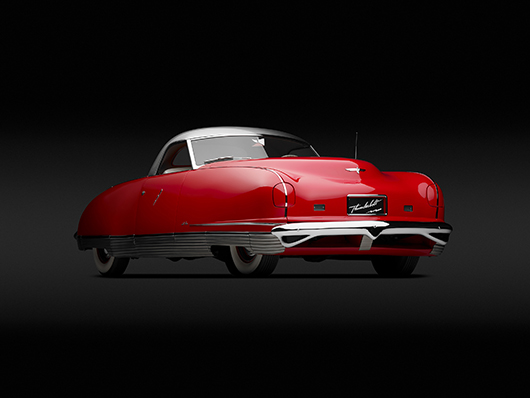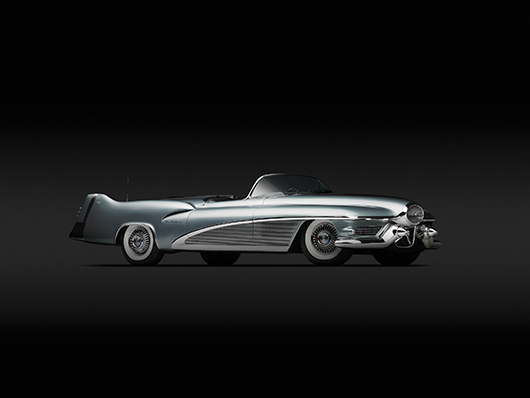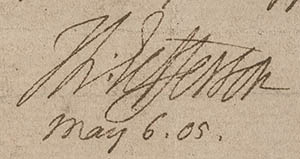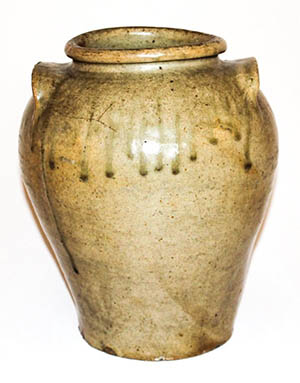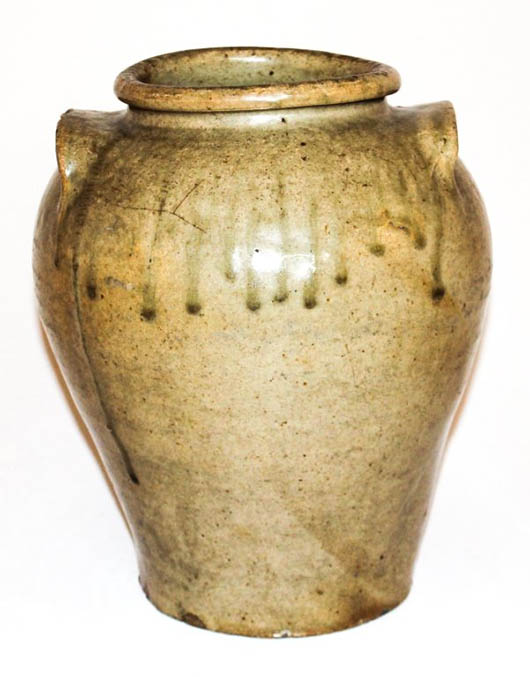Dorflinger punch set, $132,000, DuMouchelles

A turn-of-the-century 15-piece Dorflinger Montrose green-to-clear glass punch bowl set sold for $132,000 at an auction held Sept. 12-14 by DuMouchelles in Detroit. Also, an American brilliant cranberry cut-to-clear glass and Gorham sterling jug finished at $33,000; a Hawkes Queens glass punch bowl with 12 cups gaveled for $21,600; a Hawkes cut glass Jack-in-the-Pulpit vase climbed to $18,000; and an American Russian pattern brilliant cut glass salads set, circa 1800, went to a determined bidder for $19,200. Prices include a 20 percent buyer’s premium.
Netherlands trial specimen, $9,195, Archives International
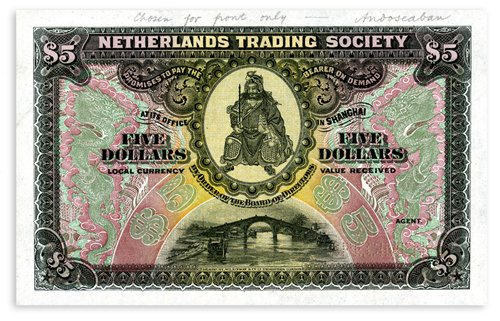
A beautiful Netherlands Trading Society $5 color trial specimen sold for $9,195 at an auction held Sept. 27 in Hong Kong, China by Archives International Auctions LLC, based in Fort Lee, N.J. Also, a 36th year (1947) U.S. $5,000 Short Term Treasury Note of the Republic of China (First Issue) realized $1,839; a 1948 Central Bank of China unlisted 250,000 Customs Gold Units specimen essay issue fetched $1,302; and a Commercial Bank of China 1920 $50 specimen banknote knocked down at $3,678. Prices include a 19 percent buyer’s premium.
Hovsep Pushman painting, $50,000, Ahlers & Ogletree

An oil on wood panel painting by the Armenian-American artist Hovsep Pushman (1877-1966), titled Sacred Lotus of the Nile, sold for $50,000 at a fall estates auction held Oct. 4-5 by Ahlers & Ogletree in Atlanta. Also, a circa 1950 figural bikini vase for Venini by Fulvio Bianconi (Italian, 1915-1996), 14 1/2 inches tall, rose to $12,500; a Louis XVI-style giltwood carved wall appliqué went for $2,500; and a horse and dog bronze sculpture in the style of Paul Edouard Delabrierre (French, 1829-1912) made $3,000. All prices quoted are hammer.
Tiffany Studios window, $71,300, Cottone Auctions

A stunning turn-of-the-century memorial stained glass window from Tiffany Studios, titled Angel of Resurrection, sold for $71,300 at a fall fine art and antiques auction held Sept. 26-27 by Cottone Auctions in Geneseo, N.Y. Also, a Tiffany Studios Poppy lamp, 24 inches tall with an overlay filigree shade 17 inches in diameter, lit up the room for $69,000; a fine Asian bronze and metal vase with cut glass liner brought $55,200; and a glazed stoneware bird tobacco jar by Martin Brothers rose to $61,000. Prices include a 15 percent buyer’s premium.
Lou Gehrig signed check, $22,600, Philip Weiss
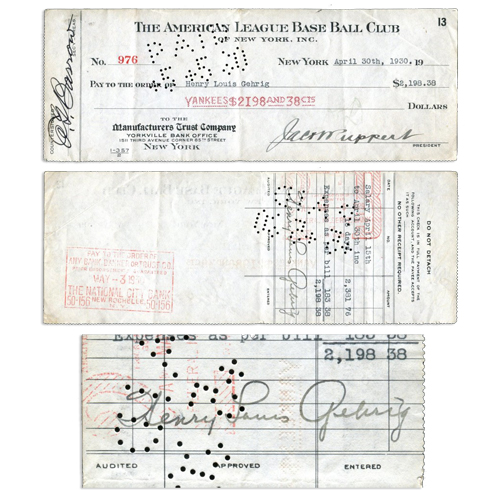
A two-week paycheck in the amount of $2,198.38, made out to New York Yankees legend Lou Gehrig in 1930 and signed by him on the back – and signed on the front by team owner Jacob Ruppert – sold for $22,600 at an auction held Sept. 30 by Philip Weiss Auctions in Lynbrook, N.Y. Also, four original Peanuts daily comic strips, drawn and signed by the late comic illustrator Charles Schulz, went for a combined $75,000; and a 1929 Kashin R-316 Babe Ruth baseball card signed by the Yankee great made $14,375. Prices include a 13 percent buyer’s premium.
Punch cigar store figure, $102,699, Showtime

A 19th century Punch cigar store wood figure, 69 1/2 inches tall and with a contemporary base, sold for $102,600 at an auction held Oct. 3-5 by Showtime Auction Services in Ann Arbor, Mich. Also, an 1890 Brunswick, Balke, Collender “Princess” saloon back and front bar with original mahogany finish achieved $79,800; a Republic Tires “Staggered Tread” paper sign, one of only four known, made $31,350; and a Campbell’s Soup porcelain thermometer hammered for $19,200. Prices include a sliding scale buyer’s premium.
Chinese imperial seal box, $90,000, Gordon S. Converse

A rare antique Chinese carved imperial seal box fitted with 16 seals of green jade circling a large central Shi-mounted seal, sold for $90,000 at an East meets West auction held Oct. 3 by Gordon S. Converse & Co. in Malvern, Pa. Also, a Qing-era zitan throne chair featuring outstanding carved panels hammered for $30,000; a heavily figured Ming Dynasty lidded jar, 20 inches tall, went for $26,400; and a set of 10 Royal Copenhagen Flora Danica reticulated plates, 8 3/4 inches in diameter, fetched $6,600. Prices include a 20 percent buyer’s premium.
Winchester Model 1873 rifle, $258,750, James D. Julia Inc.

A rare Winchester Model 1873 rifle, 1 of 1,000, sold for $258,750 at a firearms auction held Oct. 7-9 at James D. Julia Inc., in Fairfield, Maine. Also, a cased Colt #1 Baby Patterson with a 4-inch barrel went for $172,500; a Walther Armee Pistole with long barrel and matching magazine, alloy frame and original stock, $155,250; a Walther Volkspistole all sheet metal SA prototype, 9mm parabellum, $143,000; and a Boss 410 O/U sidelock ejector single trigger game gun, $138,000. Prices include a 15 percent buyer’s premium.
Cameo glass Sphinx lamp, $19,200, John W. Coker

An 18-inch-tall cameo-glass Sphinx lamp signed “Arsall” on the shade – referring to an early 20th century French designer – sold for $19,200 at an auction held Oct. 18 by John W. Coker Auctions Ltd. in New Market, Tenn. The lamp was perched atop a finely formed bronze-on-marble base, replicating an elephant, and had a domed shade executed in vibrant shades of orange, yellow and terra-cotta. The central figure was the Great Sphinx of Giza. The lamp had an estimate of $1,000-$2,000. The price includes a 20 percent buyer’s premium.
Caille 25-cent roulette machine, $212,500, Victorian / Morphy’s

A Caille 25-cent roulette floor machine, made circa 1904, sold for $212,500 at an auction held Sept. 19-21 in Las Vegas, Nev., by Victorian Casino Antiques, in the first auction event conducted since the acquisition of VCA by Morphy Auctions in August. Also, a Mills 5-cent Duplex floor wheel machine, circa 1899, realized $108,000; a Mills 5-cent Violano Virtuoso, patented in 1912, hammered for $51,600; and a Trap the Snake three-reel bell slot machine hit $45,000, possibly a record for a three-reel machine. Prices include a 20 percent buyer’s premium.
Scrimshaw whale’s tooth, $123,000, Skinner Inc.
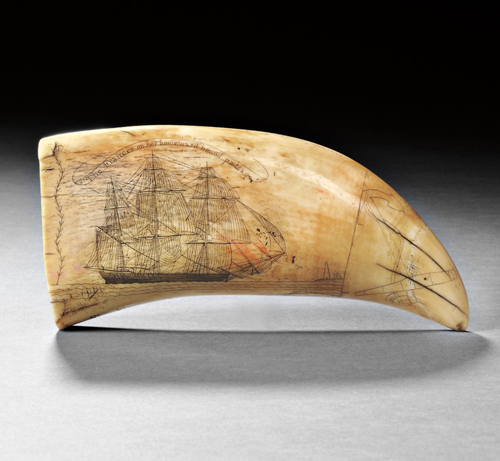
A scrimshaw whale’s tooth showing the whale ship Frances of New Bedford, Mass., by Frederick Myrick of Nantucket (circa 1828-1829) sold for $123,000 at an American furniture and decorative arts auction held Oct. 26 by Skinner Inc. in Boston. Also, a mid-19th century American School portrait of a curly-haired, blue-eyed young girl wearing blue shoes, unsigned, made $36,900; and an unsigned oil on canvas painting by Thomas Chambers (American/British, 1808-1860) rose to $25,830. Prices include a 23 percent buyer’s premium.
Steinway grand piano, $39,975, John Moran
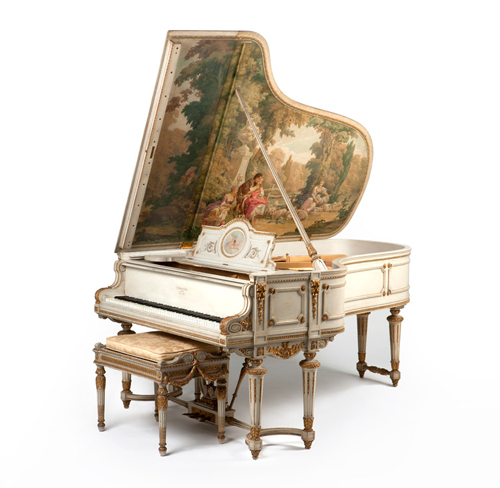
A Louis XVI-style Steinway Model B grand piano, serial # 99,999, painted with a “fete galante” by Arthur Thomas in 1907, sold for $39,975 at a fall decorative arts auction held Sept. 23 by John Moran Auctioneers in Pasadena, Calif. Also, a Galle cameo glass vase marking the 1914 Battle of Lorraine brought $11,685; a large Meissen allegorical ewer modeled after “Water” in J.J. Kandler’s Four Elements series fetched $9,840; and a pair of large Empire-style patinated bronze candelabra went for $5,400. Prices include a 20 percent buyer’s premium.
Samuel Robb Indian, $40,625, Doyle New York

A 19th century carved, painted cigar store Indian maiden attributed to Samuel Anderson Robb (1851-1928), 56 inches tall, sold for $40,625 at an American paintings, furniture and decorative arts auction held Oct. 1 by Doyle New York in New York City. Also, an 1894 seascape of Long Island’s Rockaway Beach by William Trost Richards (1833-1905) brought $62,500; a second seascape by Trost made $40,625; and a pair of portraits done in 1845 by Joseph Whiting Stock (1815-1855) went for a combined $46,875. Prices include a 25 percent buyer’s premium.
Diego Giacometti table, $204,000, Kaminski

A bronze and glass table creation by Diego Giacometti with birds motif, titled Console aux Oiseaux, sold for $204,000 at a modern and contemporary sale held Sept. 7 by Kaminski Auctions in Beverly, Mass. Also, a rare Hans Wegner upholstered Peacock chair brought $42,000, a record for the Danish designer; a tapestry designed by the artist Alexander Calder to celebrate America’s bicentennial in 1976, titled Trois Spirales, rose to $11,400; and a watercolor painting by French artist Raoul Dufy made $19,680. Prices include a 17 percent buyer’s premium.
Edouard Cortes work, $36,800, Burns White

A winter scene in Paris oil painting by the French post-impressionist Edouard Leon Cortes (1882-1969), titled Soir de Hiver, sold for $36,800 at a fine art and antiques auction held Sept. 4 by Burns White Galleries in Tampa, Fla. Also, a second oil on canvas by Cortes, titled Le Louvre, went for $21,850; a painting by Eugenio Zampighi (Italian, 1859-1944), titled Family Kitchen, realized $14,950; and a beautiful set of four antique French doors, possibly from the period of Louis XVI, changed hands for $9,440. Prices include a 15 percent buyer’s premium.
1955 Porsche Speedster, $198,000, Morphy’s

A sleek 1955 Porsche Speedster car, one of only around 1,200 pre-A models built and showing just 49,000 miles on the odometer, sold for $198,000 at an automobile auction held Oct. 11 by Morphy’s in Denver, Pa. Also, a 1963 Porsche 356B T-8 roared to $121,000; a 1952 Jaguar XK120 sped off at $88,000; a 1987 Ferarri Testarossa hammered for $85,800; a 1972 Jaguar XKE convertible in a sable/biscuit color scheme brought $74,800; and a 1966 Chevrolet Corvette convertible made $71,500. Prices include a 10 percent buyer’s premium.
John Lennon letter, $28,171, RR Auction

A letter handwritten by Beatle John Lennon to New York broadcasting legend Joe Franklin, in which Lennon makes a case for acceptance of Yoko Ono’s music, sold for $28,171 at a modern music auction held online from Oct. 16-23 by RR Auction, based in Boston. The letter was written on Apple memorandum letterhead and dated Dec. 13, 1971. Also, a Dee Dee Ramone-owned and stage-used Fender P-bass guitar fetched $37,694; and 1969 stock transfer forms signed by all four Beatles hit $16,377. Prices include a 22.5 percent buyer’s premium.
Charles Rohlfs desk, $255,750, Rago Arts
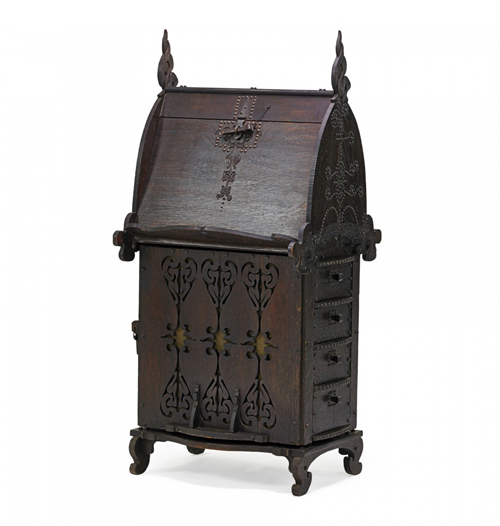
A drop-front desk made by Charles Rohlfs sold for $255,750 at a 20th century decorative arts and design auction held Oct. 18-19 by Rago Arts & Auction Center in Lambertville, N.J. Also, a Paul Evans sculpture front cabinet changed hands for $183,750; a Harry Bertoia monumental sculpture screen realized $135,750; a Newcomb College tile frieze finished at $81,250; a Galle table lamp lit up the room for $81,250; and a Tiffany Studios Dragonfly floor lamp went for $68,750. Prices include a 25 percent buyer’s premium.
Robert McCall spacescape, $245,000, Heritage Auction

Robert Theodore McCall’s visionary spacescape Earth Orbit 98, 1977, sold for $245,000 at an Illustration Art Signature Auction held Oct. 17-18 by Heritage Auctions in New York City. Also, Chesley Bonestell’s primordial painting Beginning of the World (The Earth is Born), the cover image for the Dec. 8, 1952 edition of Life magazine, hammered for $197,000; Bonestell’s Separation Over the Pacific brought $53,125; and three of six paintings in the auction by Patrick Nagel hit $137,000 each. Prices include a 20 percent buyer’s premium.

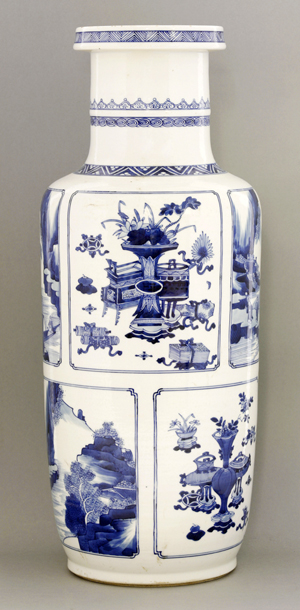
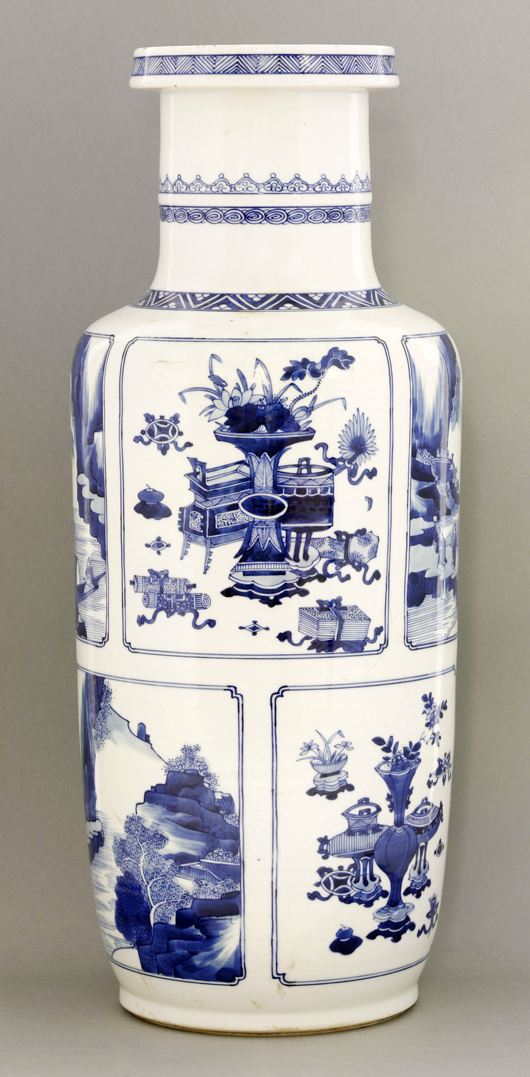
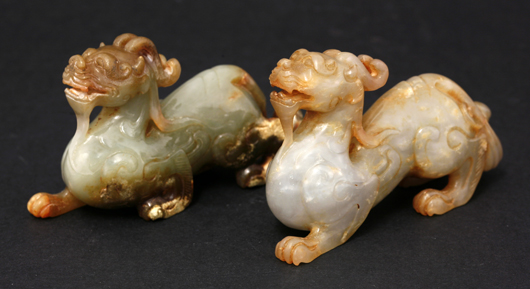


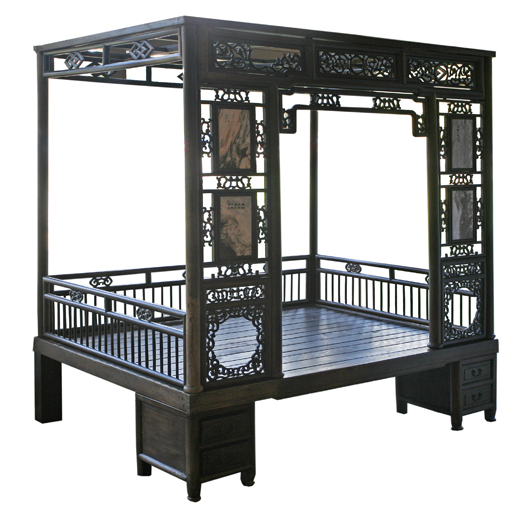

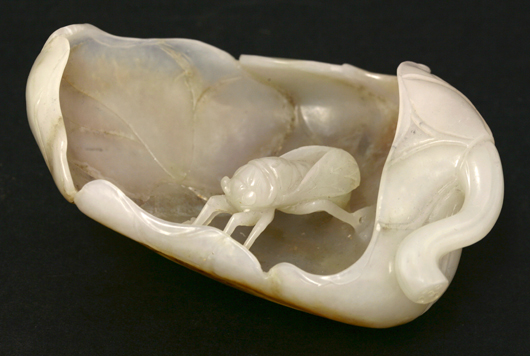


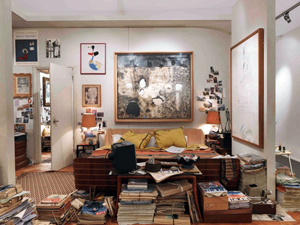
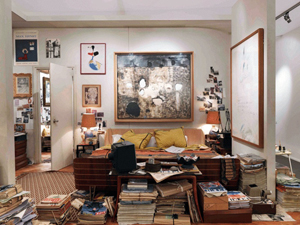
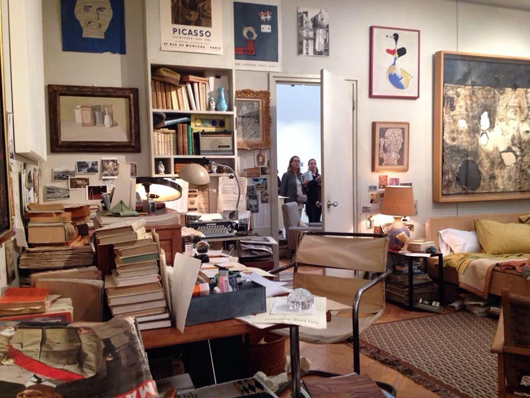
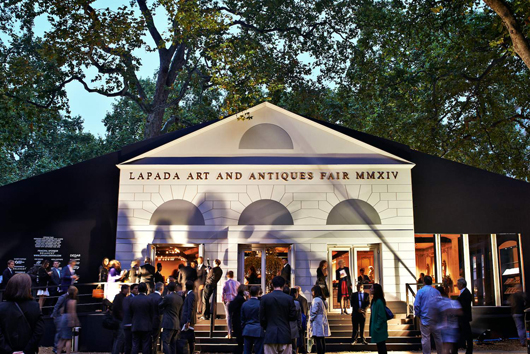
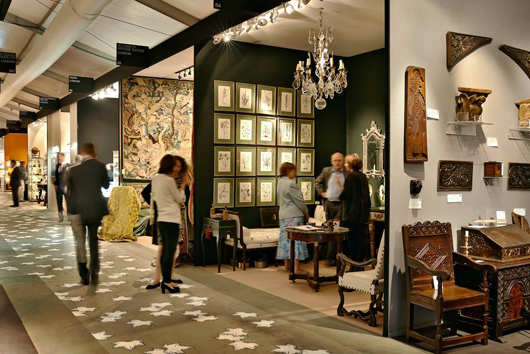
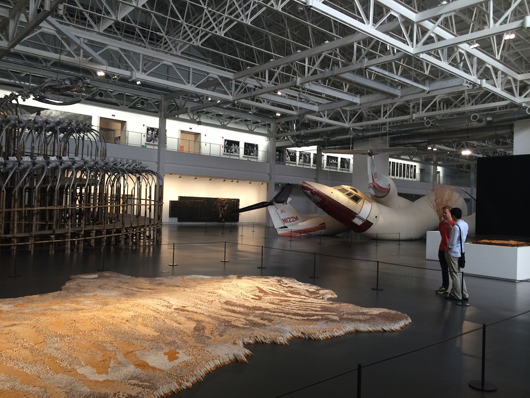
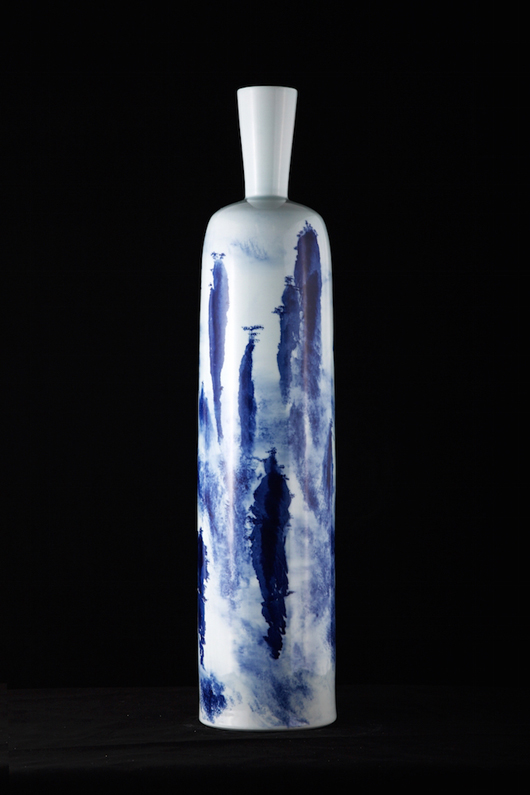
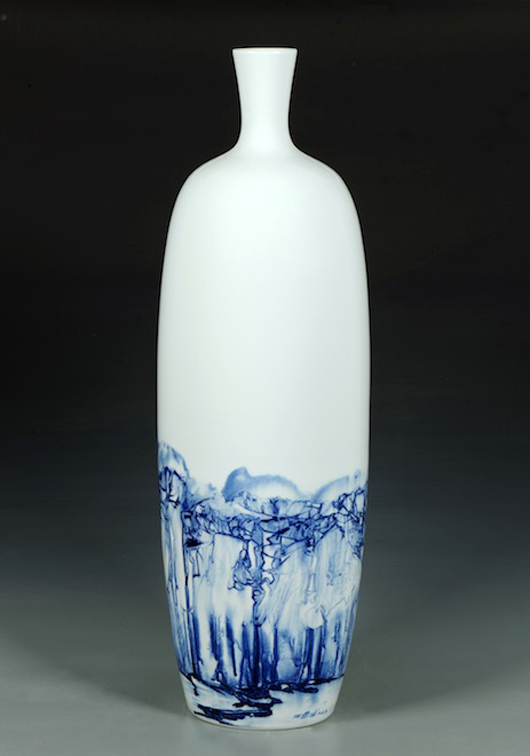
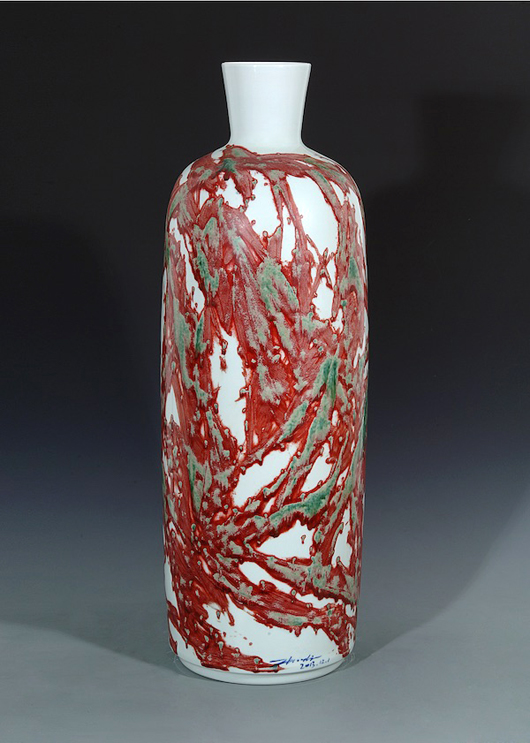



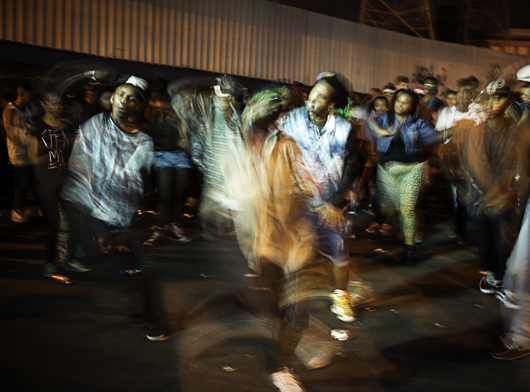
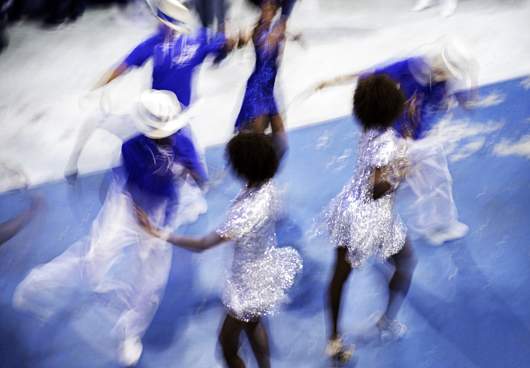
.jpg)
.jpg)
.jpg)



